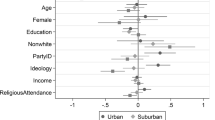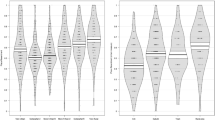Abstract
What are the behavioral consequences of municipal identity? A long tradition of public policy theory has emphasized how municipal policymaking is shaped by local residents’ shared interest in the prestige, power, and economic growth of their cities. A separate tradition of social identity theory shows that perceived membership in politically salient groups, including place-based identities, shapes political behavior, particularly in the context of intergroup rivalry. This paper integrates insights from these two traditions, providing a novel analysis of municipalities as a source of meaningful group identity. Using two large Canadian surveys, we measure municipal identity as a social identity, demonstrating that municipalities provide a meaningful basis of social identity for many individuals. We then show that municipal identity has important political correlates: strong municipal identifiers have higher levels of interest in municipal politics, higher participation in municipal elections, and distinctive policy preferences on issues related to municipal status and intermunicipal competition. We discuss the implications of our findings for political behavior, municipal politics, and social identity research.





Similar content being viewed by others
Notes
Replication materials for this study can be accessed at: https://doi.org/10.5683/SP2/DNQLRO.
This scale shares similarities with the Identification with a Psychological Group (IDPG) scale proposed by Mael and Tetrick (1992), variations of which have been used to study a range of social identities in political science (e.g. Greene 2000; Lacombe et al. 2019; Besco 2015; Goodyear-Grant and Tolley 2019).
One exception is Lunz Trujillo (2021), who in a working paper uses a similar scale to measure “rural” identity.
For a recent exception, see Hooghe and Stiers (2021), who examine the relationship between identification with Ghent, Belgium and immigrant attitudes.
This overlap is more likely in the more consolidated boundaries that are characteristic of Canadian municipalities than in the United States, where extensive municipal fragmentation is more common.
The OEPS was undertaken by a team of researchers led by Nathan Grasse at Carleton University.
In Huddy et al. (2015), \(\alpha\) = 0.74 and 0.85 for the partisan identity battery across the two samples.
In the Supplementary Material (SM2) we show that our results are substantively identical when using Monte Carlo integration to propagate uncertainty in the latent measure through subsequent regression models.
While Cara Wong found that homeownership was not consistently related to local attachment, we would ideally also examine the relationship between home ownership and municipal identity, but we lack a homeownership variable in our full sample. However, analyses on a restricted sample of Calgarians for which we have data does not find a relationship between homeownership and municipal identity (see SM4).
Unfortunately, we do not have access to data that would allow for a formal test of the difference between partisan identity and municipal identity. Comparing our results with a measure of national identity using replication data from Levendusky (2017), which uses a nearly identical social identity question battery, we find that Calgary municipal identity is 0.07 lower, on average, than American national identity (p < 0.01) and Ontario municipal identity is 0.25 lower, on average, than American national identity (p < 0.01). These results suggest, unsurprisingly, that municipal identity in Canada does not rival the strength of American national identity, but comes reasonably close in places with particularly strong levels of municipal identity. Once again, however, results from Huddy et al. (2015) using an identical question battery suggest that Canadian municipal identity is very similar in magnitude to American partisan identity.
The difference between the highest values in Ontario and Calgary’s average value (0.74) may be due in part to the difference in question wording between “Calgarian” and “a [municipality name] person”. We note that none of our findings depend on the baseline difference in municipal identity between the two samples. We hope to explore the measurement implications of these wording strategies in future research.
We show in SM4 that the results discussed here are substantively identical in an OLS model without fixed effects and in a multilevel linear model with varying intercepts by municipality.
For example, Wong (2010) examines the relationship between Black, Hispanic, and immigrant generation and place identity, but her results yield inconclusive patterns.
Because we have rescaled all variables in these models, we note that “weak identifiers”, in our models, are those with the minimum observed municipal identity value in our sample, and “strong identifiers” are those with the maximum observed municipal identity value.
Full tables along with linear probability models are in SM6.
References
Allport, G. W. (1955). The nature of prejudice. Cambridge, MA: Addison-Wesley Publishing.
Altman, I., & Low, S. M. (Eds.). (1992). Place attachment. New York: Plenum Press.
Anzia, S. F. (2021). Party and ideology in American local government: An appraisal. Annual Review of Political Science, 24(1), 233.
Beck, P. A., Dalton, R. J., Greene, S., & Huckfeldt, R. (2002). The social calculus of voting: Interpersonal, media, and organizational influences on presidential choices. American Political Science Review, 96(1), 57–74.
Besco, R. (2015). Rainbow coalitions or inter-minority conflict? Racial affinity and diverse minority voters. Canadian Journal of Political Science, 48(2), 305–328.
Blais, A., & St-Vincent, S. L. (2011). Personality traits, political attitudes and the propensity to vote. European Journal of Political Research, 50(3), 395–417.
Bobo, L. (1983). Whites’ opposition to busing: Symbolic racism or realistic group conflict? Journal of Personality and Social Psychology, 45(6), 1196–1210.
Brown, B., Perkins, D. D., & Brown, G. (2003). Place attachment in a revitalizing neighborhood: Individual and block levels of analysis. Journal of Environmental Psychology, 23(3), 259–271.
Brown, R. (2010). Prejudice: Its social psychology (p. 2). Malden, MA: Wiley-Blackwell.
Conover, P. J. (1984). The influence of group identifications on political perception and evaluation. Journal of Politics, 46(3), 760.
Cramer, K. J. (2016). The politics of resentment: Rural consciousness in Wisconsin and the rise of Scott Walker. Chicago: University of Chicago Press.
DeHoog, R. H., Lowery, D., & Lyons, W. E. (1990). Citizen satisfaction with local governance: A test of individual, jurisdictional, and city-specific explanations. The Journal of Politics, 52(3), 807.
Donnelly, M. (2021). Material interests, identity and linked fate in three countries. British Journal of Political Science, 51(3), 1119–1137.
Duckitt, J. (1989). Authoritarianism and group identification: A new view of an old construct. Political Psychology, 10(1), 63.
Fitzgerald, J. (2018). Close to home: Local ties and voting radical right in Europe. Cambridge: Cambridge University Press.
Florida, R. L. (2002). The rise of the Creative Class: And how it’s transforming work, leisure, community and everyday life. New York: Basic Books.
Goodyear-Grant, E., & Tolley, E. (2019). Voting for one’s own: Racial group identification and candidate preferences. Politics, Groups, and Identities, 7(1), 131–147.
Greene, S. (2000). The psychological sources of partisan-leaning independence. American Politics Research, 28(4), 511–537.
Hardin, R. (1995). One for all: The logic of group conflict. Princeton, NJ: Princeton University Press.
Hernandez, B., Carmen Hidalgo, M., Salazar-Laplace, M., & Hess, S. (2007). Place attachment and place identity in natives and non-natives. Journal of Environmental Psychology, 27(4), 310–319.
Holm, J., & Geys, B. (2018). Social identification and redistribution in heterogeneous federations: Evidence from Germany and Belgium. Comparative Political Studies, 51(9), 1177–1207.
Hooghe, M., & Stiers, D. (2021). Regional identity and support for restrictive attitudes on immigration. Evidence from a household population survey in Ghent (Belgium). Ethnic and Racial Studies, 44(4), 698–717.
Huddy, L. (2004). Contrasting theoretical approaches to intergroup relations. Political Psychology, 25(6), 947–967.
Huddy, L. (2013). From group identity to political cohesion and commitment. In L. Huddy, D. Sears, & J. Levy (Eds.), The Oxford Handbook of Political Psychology (2nd ed.). Oxford: Oxford University Press.
Huddy, L., & Bankert, A. (2017). Political partisanship as a social identity. Oxford research encyclopedia of politics. Oxford: Oxford University Press.
Huddy, L., & Khatib, N. (2007). American patriotism, national identity, and political involvement. American Journal of Political Science, 51(1), 63–77.
Huddy, L., Mason, L., & Aarøe, L. (2015). Expressive partisanship: Campaign involvement, political emotion, and partisan identity. American Political Science Review, 109(1), 1–17.
Jacobs, N. F., & Munis, B. K. (2019). Place-based imagery and voter evaluations: Experimental evidence on the politics of place. Political Research Quarterly, 72(2), 263–277.
Kogan, V., & Einstein, K. L. (2015). Pushing the city limits: Policy responsiveness in municipal government. Urban Affairs Review, 52(1), 3–32.
Krupat, E. (1985). People in Cities: the urban environment and its effects. Cambridge: Cambridge University Press.
Lacombe, M. J., Howat, A. J., & Rothschild, J. E. (2019). Gun ownership as a social identity: Estimating behavioral and attitudinal relationships. Social Science Quarterly, 100(6), 2408–2424.
Lalli, M. (1992). Urban-related identity: Theory, measurement, and empirical findings. Journal of Environmental Psychology, 12(4), 285–303.
Lazarsfeld, P. F., Berelson, B., & Gaudet, H. (1948). The People’s Choice: How the voter makes up his mind in a presidential campaign (2nd ed.). New York: Columbia University Press.
Levendusky, M. S. (2017). Americans, not partisans: Can priming American national identity reduce affective polarization? The Journal of Politics, 80(1), 59–70.
Lewicka, M. (2010). What makes neighborhood different from home and city? Effects of place scale on place attachment. Journal of Environmental Psychology, 30(1), 35–51.
Lewicka, M. (2011). Place attachment: How far have we come in the last 40 years? Journal of Environmental Psychology, 31(3), 207–230.
Lucas, J. (2020). Do "non-partisan" municipal politicians match the partisanship of their constituents? Urban Affairs Review. https://doi.org/10.1177/1078087420958074.
Lunz Trujillo, K. (2021). When rural identity matters: The case of anti-intellectualism. Working Paper.
Lyons, J., & Utych, S. M. (2021). You’re not from here!: The consequences of urban and rural identities. Political Behavior,. https://doi.org/10.1007/s11109-021-09680-3.
Mael, F. A., & Tetrick, L. E. (1992). Identifying organizational identification. Educational and Psychological Measurement, 52(4), 813–824.
Mason, L. (2018). Uncivil agreement: How politics became our identity. Chicago: The University of Chicago Press.
Massey, D. B. (1994). Space, place, and gender. Minneapolis: University of Minnesota Press.
Munis, B. K. (2020). Us over here versus them over there...literally: Measuring place resentment in American politics. Political Behavior,. https://doi.org/10.1007/s11109-020-09641-2.
Munis, B. K. (2021). Place, candidate roots, and voter preferences in an age of partisan polarization: Observational and experimental evidence. Political Geography, 85, 102345.
Peterson, P. E. (1981). City limits. Chicago: University of Chicago Press.
Proshansky, H. M., Fabian, A. K., & Kaminoff, R. (1983). Place-identity: Physical world socialization of the self. Journal of Environmental Psychology, 3(1), 57–83.
Rico, G., & Jennings, M. K. (2012). The intergenerational transmission of contending place identities. Political Psychology, 33(5), 723–742.
Sherif, M. (1961). Intergroup conflict and cooperation: The robbers cave experiment. Norman: University of Oklahoma.
Sides, J., Tesler, M., & Vavreck, L. (2018). Identity crisis: The 2016 presidential campaign and the Battle for the Meaning of America. Princeton, NJ: Princeton University Press.
Stone, C. N. (1989). Regime politics: Governing Atlanta, 1946–1988. Lawrence, Kan: University Press of Kansas.
Tajfel, H. (1978). The social psychology of minorities., Minority Rights Group Report London: Minority Rights Group.
Tajfel, H. (1981). Human groups and social categories: Studies in social psychology. Cambridge: Cambridge University Press.
Tajfel, H., & Turner, J. (1979). An integrative theory of intergroup conflict. In W. Austin & S. Worchel (Eds.), The social psychology of inter-group relations (pp. 33–47). Monterey, CA: Brooks/Cole.
Tausanovitch, C., & Warshaw, C. (2014). Representation in municipal government. American Political Science Review, 108(3), 605–641.
Turner, J. C. (1987). Rediscovering the social group: Self-categorization theory. New York: B. Blackwell.
Wester-Herber, M. (2004). Underlying concerns in land-use conflicts: The role of place-identity in risk perception. Environmental Science & Policy, 7(2), 109–116.
Wong, C. (2010). Boundaries of obligation in American politics: Geographic, national, and racial communities. Cambridge: Cambridge University Press.
Acknowledgements
Jack Lucas acknowledges funding from the University of Calgary School of Public Policy, and from the Social Sciences and Humanities Research Council of Canada (IDG 430-2016-00181).
Author information
Authors and Affiliations
Corresponding author
Additional information
Publisher's Note
Springer Nature remains neutral with regard to jurisdictional claims in published maps and institutional affiliations.
Supplementary Information
Below is the link to the Supplementary Information.
Rights and permissions
About this article
Cite this article
Borwein, S., Lucas, J. Municipal Identity and City Interests. Polit Behav 45, 877–896 (2023). https://doi.org/10.1007/s11109-021-09735-5
Accepted:
Published:
Issue Date:
DOI: https://doi.org/10.1007/s11109-021-09735-5




